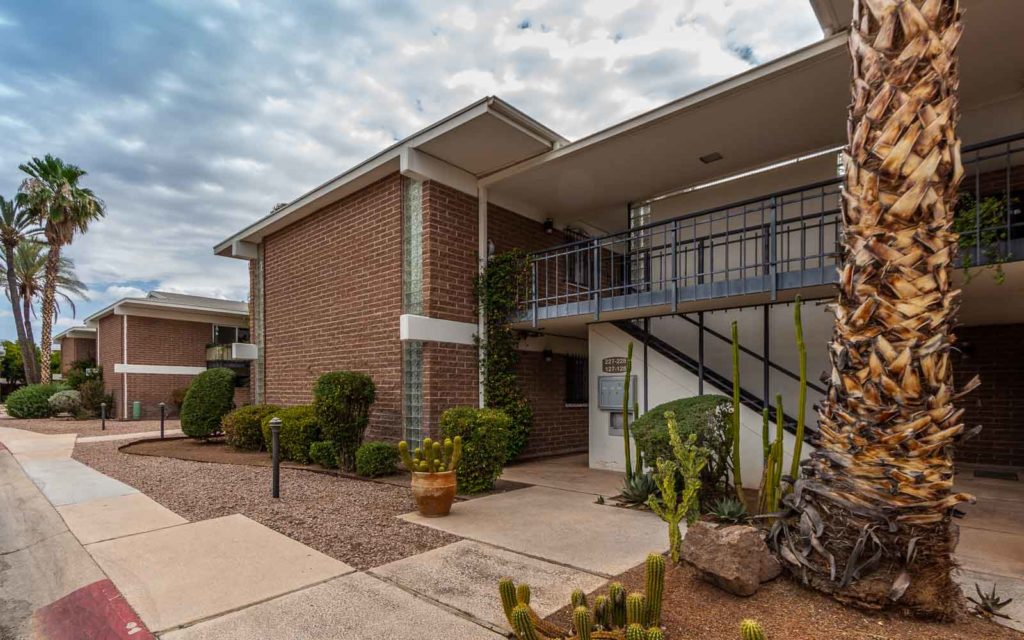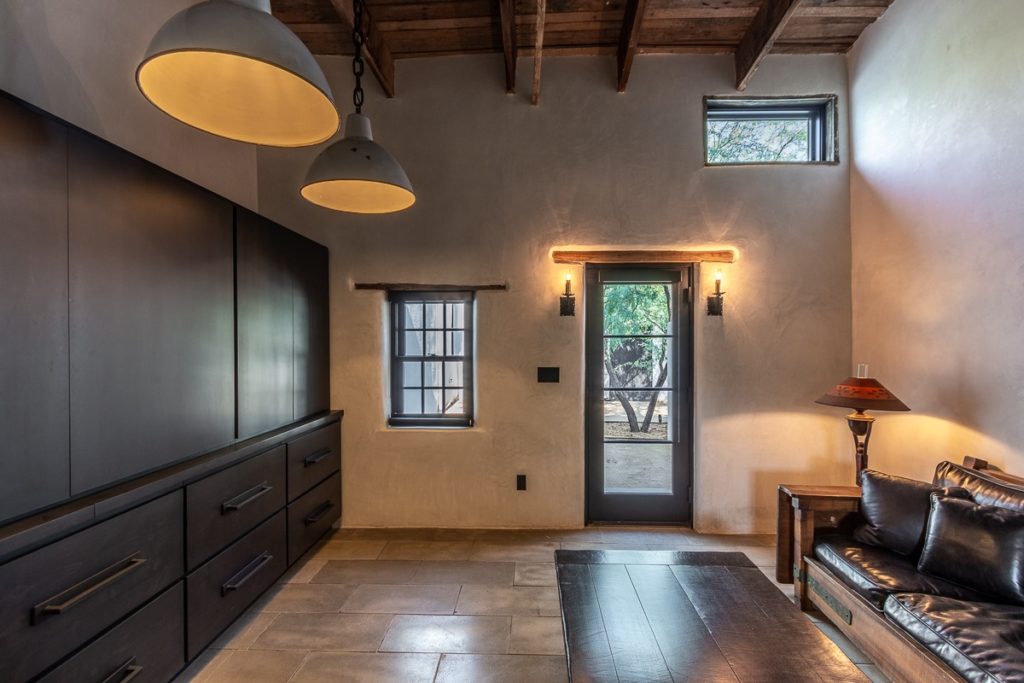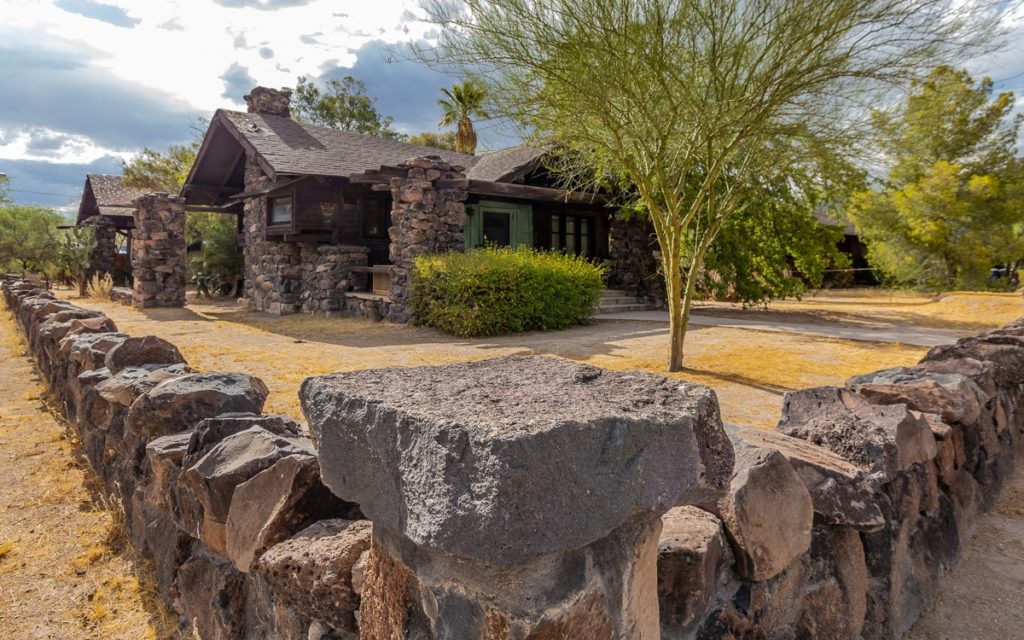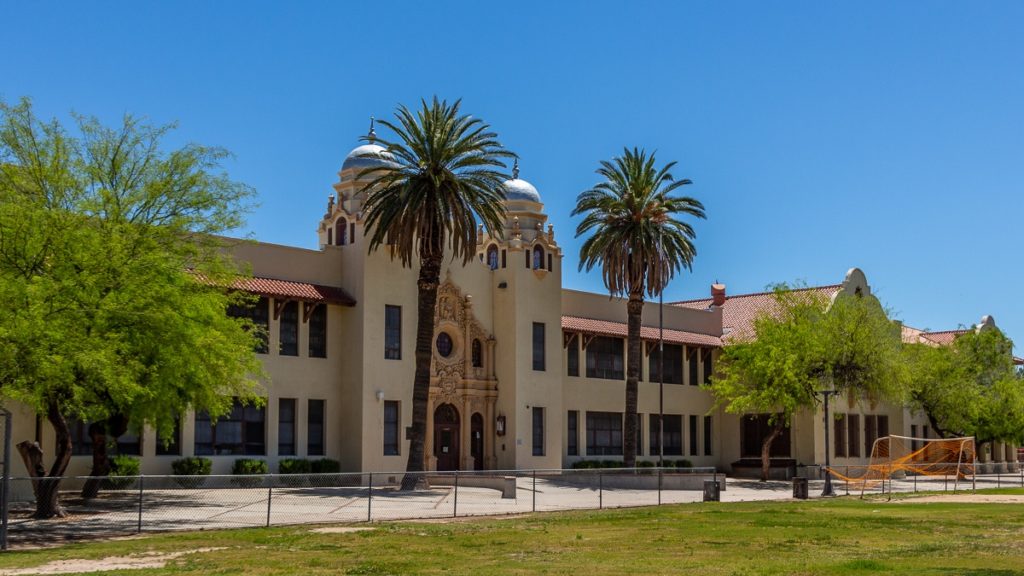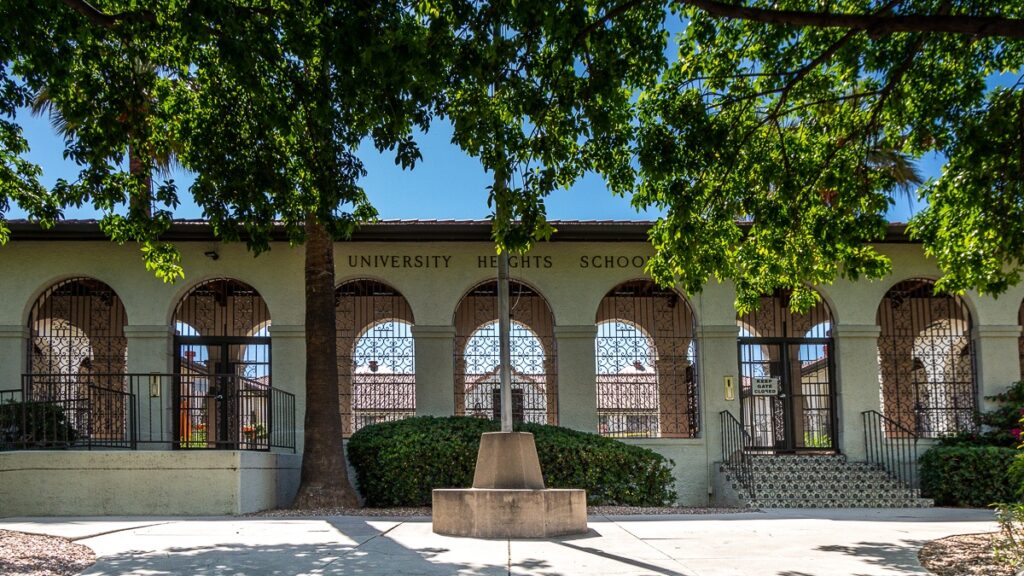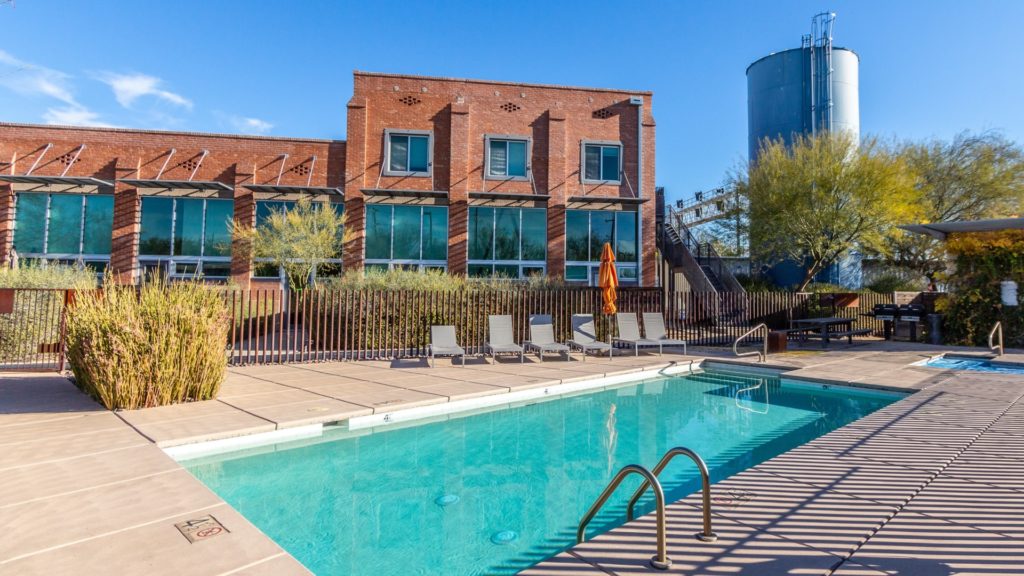Last Updated on April 13, 2023 by Kim Labriola
Did you know Tucson has over 30 Historic Districts on the National Register?
Which historic Tucson neighborhood is best for you? Where are they located? Below is an alphabetical list and map of each of Tucson’s Historic Districts and a description of what makes each area unique with links to homes currently for sale in each district.
Are you looking to buy or sell a home in a historic area? Contact us to go over your needs: Hello@RealTucson.com or 520-975-8956

1. Aldea Linda Historic District
Aldea Linda – This historic Tucson neighborhood, located near 22nd Street and Swan, is one of the smallest historic districts in town with only about 15 homes located on a single street: Calle Jabali (which translates to Wild Boar Street). Aldea Linda is Spanish for ‘beautiful little village’. Homes in this neighborhood were built between 1947-1964 and are rarely for sale, since there are so few.
Sam P. Goddard Jr. (former Arizona Governor) and his wife Julia “Judy” Hatch Goddard built their home here in 1947, then had the rest of the land subdivided. Terry Goddard was their oldest son who was recently Arizona Attorney General.
The neighborhood had tight deed restrictions which caused the houses to be set far back from the street on large lots (2.5 – 4.8 acres). The neighborhood retains much of it’s original native creosote vegetation, which smells lovely after a desert rain storm. Aldea Linda became a historic district in 2009.
More about Aldea Linda neighborhood
Search homes for sale in Aldea Linda neighborhood

2. Armory Park Historic District
Armory Park is a historic Tucson neighborhood conveniently located south of the booming downtown area, between Broadway and 18th Street and between Stone and 3rd Avenue. The neighborhood was so named because the area was a military plaza and an armory from 1862 to 1873, prior to moving to Fort Lowell, which was 7 miles northeast of Tucson at the time. Armory Park was settled by many railroad workers after the Southern Pacific arrived in Tucson in 1880.
The neighborhood is defined by wide streets with architectural styles ranging from Victorian to simpler Sonoran-style adobe row houses. Lush, mature trees, close proximity to amenities such as downtown shops, restaurants, arts, and entertainment, all continue to make this neighborhood popular. Armory Park is one of the most walkable neighborhoods in Tucson, ranking #4 according to Walkscore
It was added to the National Register of Historic Places in 1976.
More about Armory Park
Search homes for sale in Armory Park neighborhood
Interested in buying or selling a home in Tucson? Contact us to go over your needs. 520-975-8956 or Hello@RealTucson.com
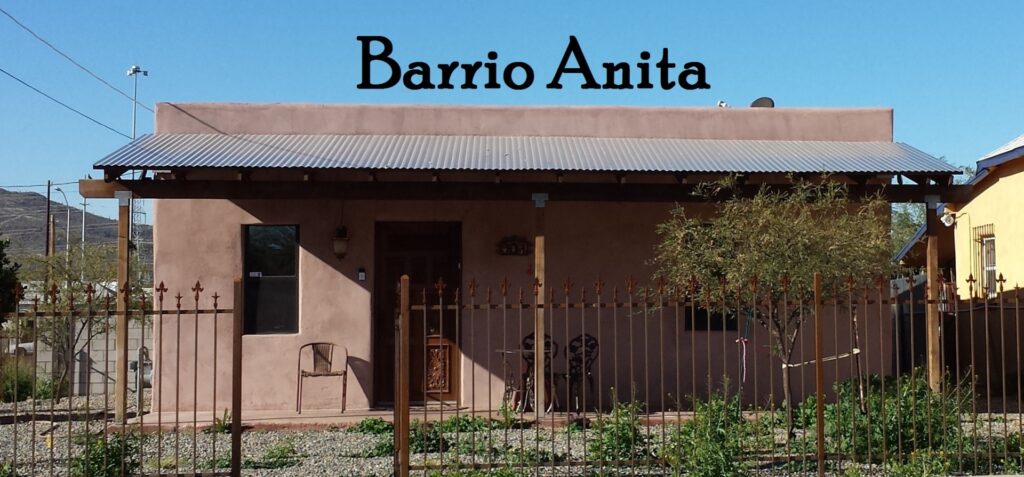
3. Barrio Anita Historic District
The land that Barrio Anita sits on was purchased by Thomas Hughes, a prominent businessman, who was the lesser known brother of Sam Hughes. Hughes named the streets after his friends and his sister Annie, which quickly became known as Anita. Situated between I-10 and Granada, between Speedway and St. Mary’s Road, this small neighborhood was mostly built out by the 1920s. After WWII many structures were torn down and quite a few homes in Barrio Anita were constructed more recently. The historic homes located here were built in many different styles such as: Sonoran, Queen Anne, Bungalow, Mission Revival but were usually constructed out of adobe.
Search homes for sale in Barrio Anita
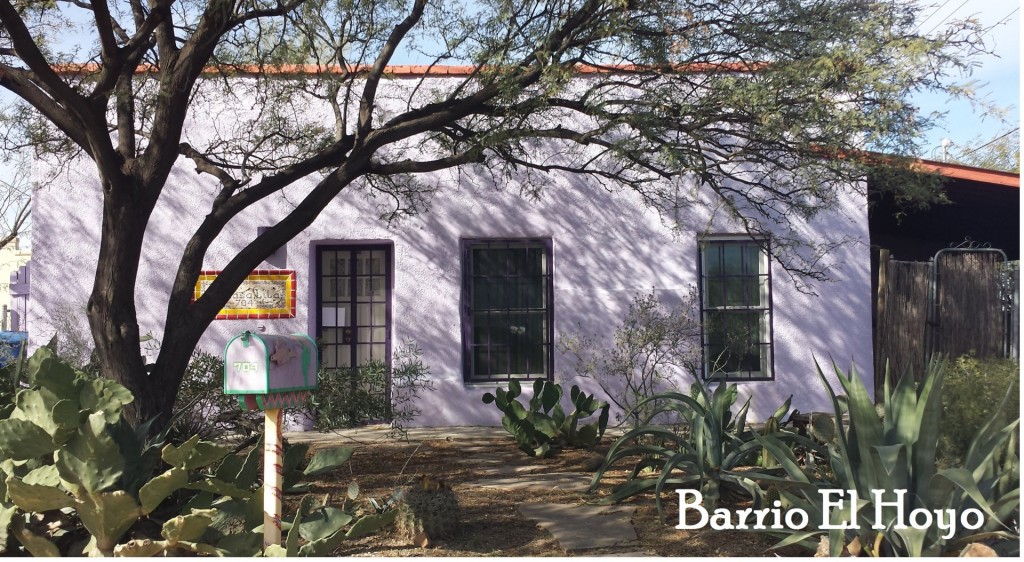
4. Barrio El Hoyo Historic District
Barrio El Hoyo, Barrio Membrillo, and Barrio Libre comprise the neighborhood that may be better known among locals as Barrio Viejo (and sometimes referred to as Barrio Historico). This historic Tucson neighborhood is located just southwest of Tucson’s bustling downtown area, but these 3 neighborhoods have a surprisingly slower paced feel, due in part to the narrow streets.
El Hoyo translates to ‘the hole’ because of the area’s topography. Until the 1880s the land was cultivated farm land with close proximity to the once flowing Santa Cruz River. Leopoldo Carrillo purchased the land where he grew many types of fruit trees, known as Carrillo Gardens, which also had spring fed lakes. Emanuel Drachman purchased the land in 1903, which he developed and renamed Elysian Grove, an amusement park with a baseball diamond and theater in 1910. In 1912 it was visited by Teddy Roosevelt. Elysian Grove shut down in 1915 due to financial problems. The land was sold and subdivided. Part of this land became Carrillo School, built in 1930, designed by Merritt Starkweather, a prominent architect who also designed The Arizona Inn. Barrio El Hoyo was mostly built out by 1931. The homes were built in Sonoran Transitional style, which blended traditional Sonoran with non-Hispanic elements.
More about Barrio El Hoyo historic district
Search homes for sale in Barrio El Hoyo
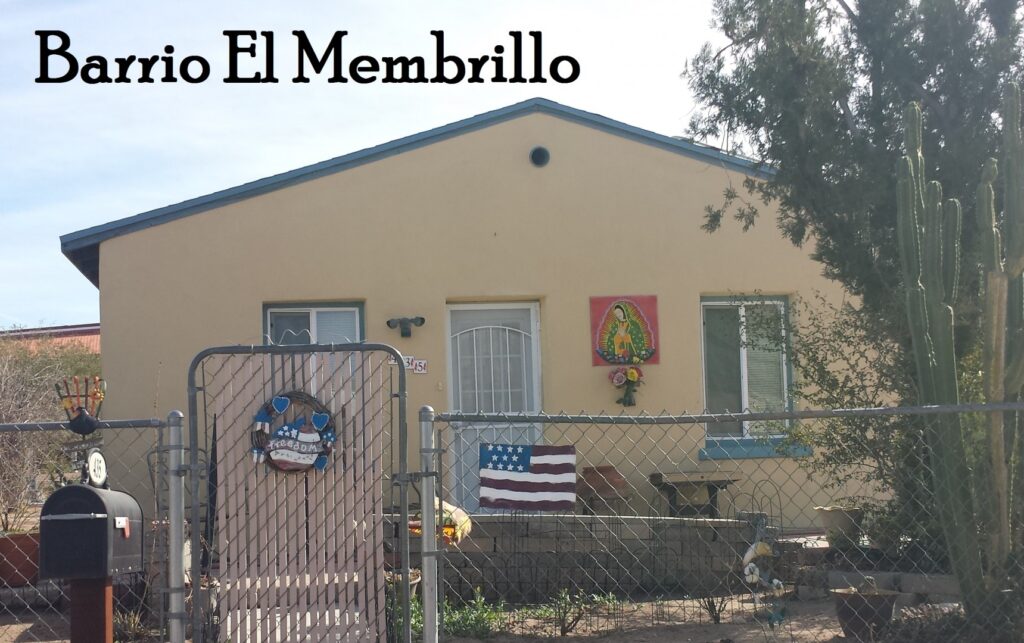
5. Barrio El Membrillo Historic District
Barrio El Membrillo is named for the quince trees that grew in this area, this small neighborhood of only 13 buildings was once much larger, but became victim to the interstate Highway System with the construction of I-10 in the 1950s and ‘urban renewal’ in the 1960s. The highway construction eliminated half the structures here and the development of the Tucson Convention Center leveled many more homes in the 1960s. The neighborhood consists of Sonoran architecture built primarily of adobe.
Search homes for sale in Barrio El Membrillo
Interested in buying or selling a home in Tucson? Contact us to go over your needs. 520-975-8956 or Hello@RealTucson.com

6. Barrio Libre Historic District
Barrio Libre – This historic district sits just east of Barrio El Hoyo and south of Tucson’s downtown area. Barrio Libre is the largest portion of Barrio Viejo area. This neighborhood was built between 1860s and 1920s (pre- and post-railroad) and was known as Barrio Libre (Free District) because it was out of the city’s jurisdiction. Among the first residents were a few business people and other professionals, but most were laborers. Most of the older buildings were Sonoran row houses built of adobe. Structures built a little later were typically non-Hispanic style homes in the Victorian, Queen Anne, or American Traditional styles.
Search homes for sale in Barrio Libre
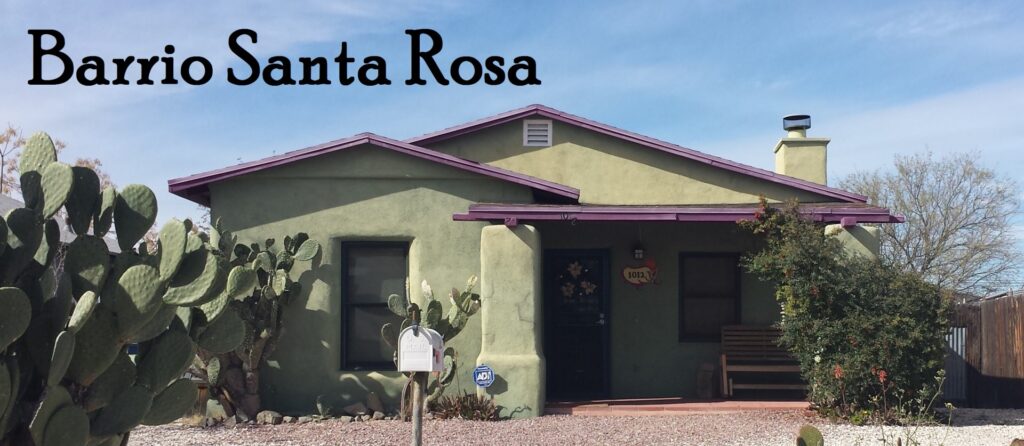
7. Barrio Santa Rosa Historic District
Barrio Santa Rosa – Close to downtown, this historic Tucson neighborhood is roughly bounded by 18th Street and 22nd Street to the north and south, 6th Avenue and Meyer to the east and west. It’s one of the most walkable neighborhoods in Tucson.
This area’s architecture consists of Sonoran Row Houses, Post-war Territorial, Ranch, Queen Anne, Bungalow, Craftsman, Spanish Revival, and Mission Revival. This neighborhood was listed in the National Register of Historic Districts in 2011. Sunset Magazine featured some of the new construction projects in the neighborhood.
Search homes for sale in Barrio Santa Rosa

8. Blenman-Elm Historic District
Blenman-Elm is a popular neighborhood in midtown Tucson that offers diverse architectural styles in a convenient urban setting. Located just east of Banner University Medical Center, the “L” shaped neighborhood covers approximately one square mile and is bordered by Grant Road on the north, Speedway on the south, Country Club on the east and Campbell on the west.
Development dates back to 1900 when developer Andrew Olsen built a home at the NE corner of Helen Street and Plumer Avenue. Growth was slow until a boom occurred in 1936. Peak growth was in 1955. By 1960 the area was mostly built-out. Twenty-one of the homes were designed by architect Josias Joesler. Historical Landmarks include; Arizona Inn(1930), Peter and Paul Catholic Church (1931) and Blenman Elementary School (1942). The district was designated to the National Register of Historic Places in 2002.
More about Blenman-Elm neighborhood
Search homes for sale in Blenman-Elm
Interested in buying or selling a home in Tucson? Contact us to go over your needs. 520-975-8956 or Hello@RealTucson.com
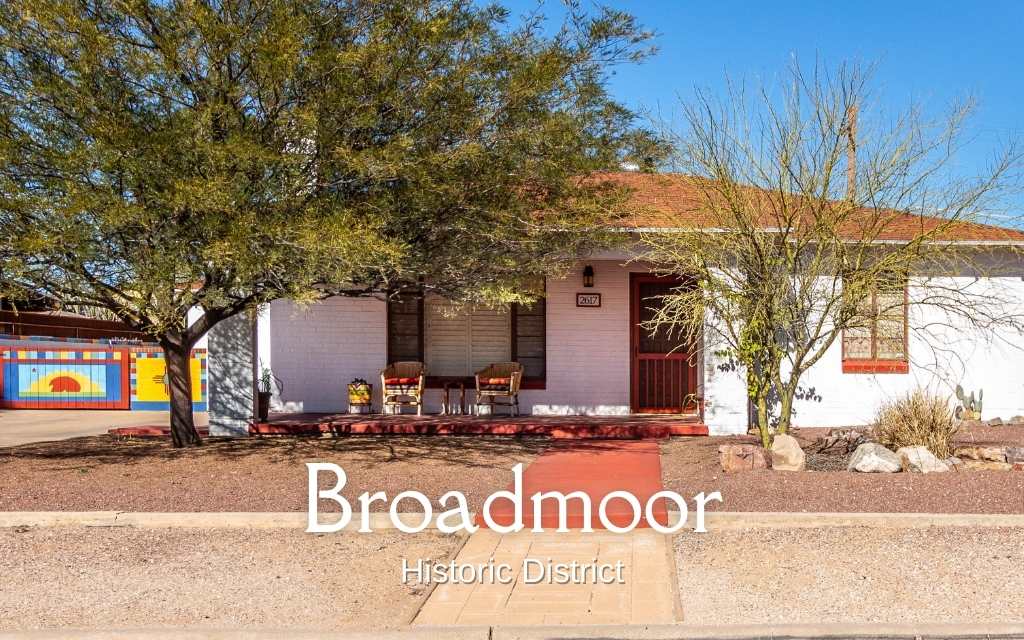
Broadmoor Historic District
Located along the eastern portion of Tucson’s Sunshine Mile, Broadmoor was built upon land previously used as a golf course and country club. What makes this neighborhood unique is the limited access points for cars to enter the neighborhood, making this neighborhood more welcoming for pedestrians. The oleander-lined Arroyo Chico runs along the southern part of the neighborhood with a pedestrian bridge and sidewalk running north-south along a utility easement. Most of the homes are ranch style, which were built between 1944 and 1964.
The neighborhood has an active voluntary HOA which plans community social events and organizes community improvement projects, such as Malvern Plaza, a spot with picnic tables and a little free library.
The neighborhood is also close to Broadway Village, a shopping center designed by Tucson’s most well-known architect, Josias Joesler. Broadway Village along with the neighboring building, designed by Joesler’s successor Juan Worner Baz, is home to several great local restaurants including Falora Pizza, SideCar Lounge, Bisbee Breakfast Club, and Barrio Bread.
More about Broadmoor Historic District and see available homes for sale

Casitas De Castilian
Casitas De Castilian is a 120-unit masonry constructed condo complex designed by noted architect Bennie Gonzales in the late 1960s. The property features 17 acres of grassy, mature landscaping. There are also 2 pools, a clubhouse, and a tennis court for residents use. The neighborhood is a 55+ age restricted community.
More about Casitas de Castilian and search homes for sale
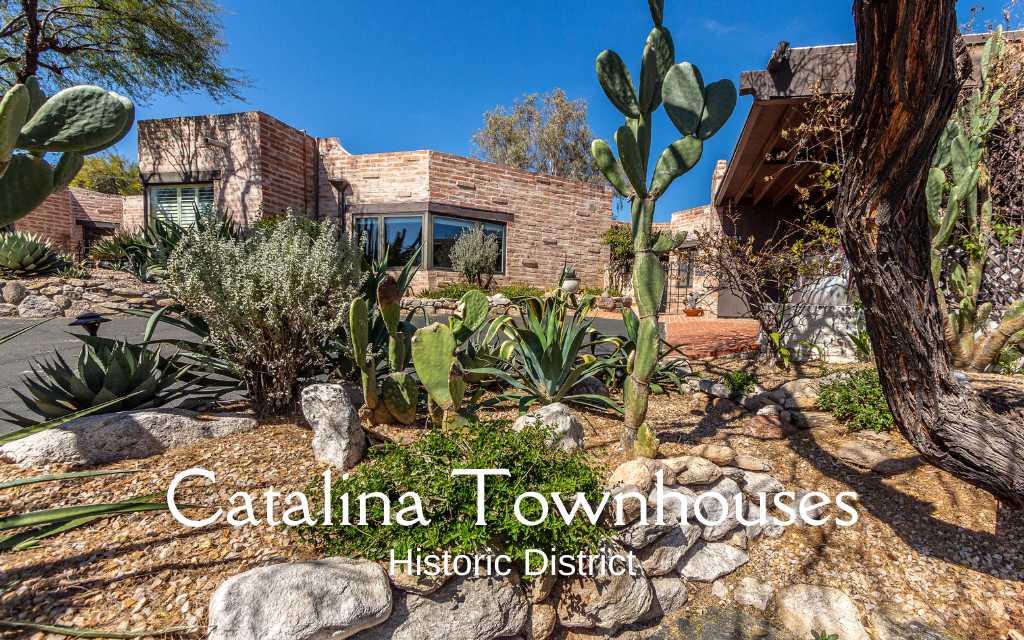
Catalina Townhouses
Catalina Townhouses is a enclave of only 14 burnt adobe townhomes designed by Mexican architect Juan Worner Baz with landscape designed by Taro Akutagawa. It’s one of 2 historic districts in the Catalina Foothills area of Tucson. John and Helen Murphey developed the neighborhood in the 1960s.
More about Juan Worner Baz and search for homes available in Catalina Townhouses

9. Catalina Vista Historic District
Catalina Vista – Bordered by Grant and Elm to the north and south and Campbell and Tucson Blvd. to the west and east, this historic Tucson neighborhood forms the missing square from Blenman-Elm L-shaped border. This quaint midtown neighborhood has a lot to offer with it’s curvilinear roads encircling a central grassy park lined with towering palm trees. A second neighborhood park features a children’s playground.
Margaret Sanger Slee, probably the most well known Catalina Vista resident, had Tucson architect Arthur Brown design a home for her, after trying to hire Frank Lloyd Wright, who scoffed at the idea of building on a small city lot. Catalina Vista was listed on the National Register of Historic Districts in 2003. This neighborhood is just north of the renowned Arizona Inn, which was founded by Arizona’s first female congresswoman, Isabella Greenway.
More about Catalina Vista neighborhood
Search homes for sale in Catalina Vista

10. Colonia Solana Historic District
Colonia Solana is the first Tucson neighborhood to embrace the natural desert landscape surrounding it. Located just southeast of Broadway and Country Club, this neighborhood has 123 homes on large lots. Most are Spanish Colonial Revival or Ranch style homes. Landscape architect Steven Child of San Francisco worked on the design of the neighborhood. He had a talent for incorporating the existing topography along with native plants to create a natural landscape that highlighted the Arroyo Chico, which runs within the property. Child’s design featured an informal, non-symmetrical, curvilinear layout, in contrast to the more formal El Encanto neighborhood just to the north, which was developed in the same time period.
Most homes were built between 1928 and 1960. Many of the homes were designed by such notable local architects as: Roy Place, Josias Joesler, Arthur Brown, Tom Gist, Ann Rysdale, and Merrit Starkweather. The neighborhood also is home to a 65-foot tall stucco-covered water tower designed by Roy Place in 1929 to provide water to the area. The neighborhood hugs Reid Park, Tucson’s largest park, which features a popular jogging path around the perimeter, as well as a golf course and driving range, a zoo, tennis facilities, Hi-Corbett baseball stadium, and an outdoor amphitheater.
More about Colonia Solana neighborhood
Search homes for sale in Colonia Solana neighborhood
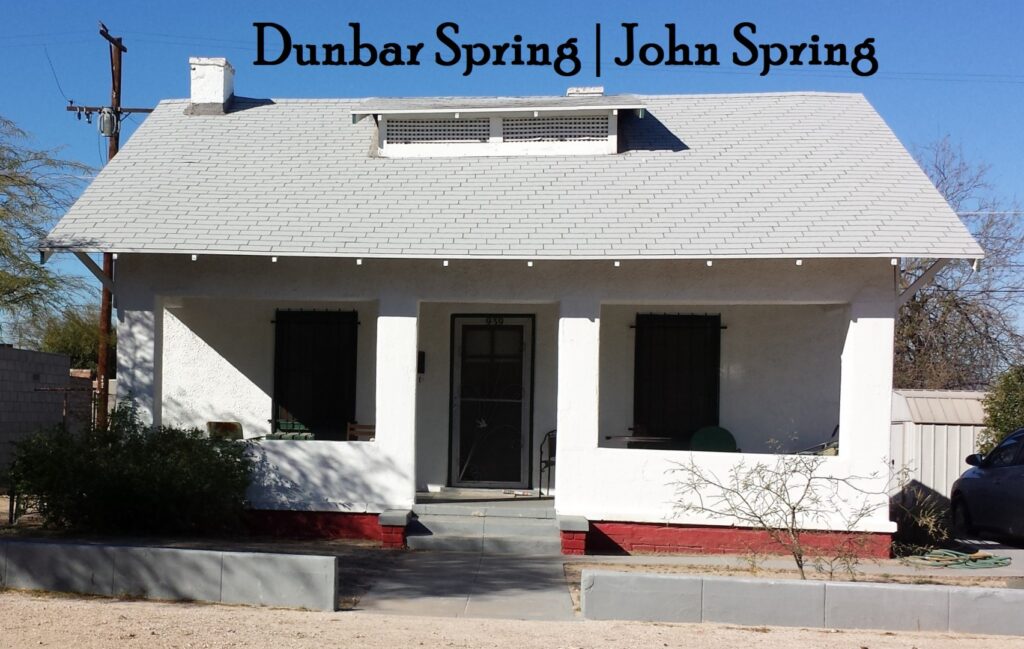
11. Dunbar Spring / John Spring Historic District
Dunbar Spring/John Spring is a historic Tucson neighborhood just north of Downtown Tucson bordered by Speedway to the north, 6th Street to the south, the railroad to the west, and Stone to the east. It was named for 2 important Tucson residents: John Spring, who was one of Tucson’s first teachers and Paul Lawrence Dunbar, who was a renowned African-American poet.
The neighborhood was built between 1896 and 1930, on land that once was a cemetery. Historically, Dunbar Spring was established as the first predominantly African-American neighborhood. It was also the location of the Dunbar School (opened in 1913), which was Tucson’s segregated elementary school. The school was later re-named John Spring Junior High School, after desegregation. The school closed in 1978 and is being restored for use as a neighborhood cultural center as well as having rented space for a barber school, a cosmetology school, a commercial kitchen, and a dance school.
Some of the architectural styles in Dunbar Spring are Bungalow, Territorial, and Victorian. According to Walkscore, Dunbar Spring ranks as the 12th most walkable neighborhood in Tucson.
Search homes for sale in Dunbar Spring neighborhood
Interested in buying or selling a home in Tucson? Contact us to go over your needs. 520-975-8956 or Hello@RealTucson.com
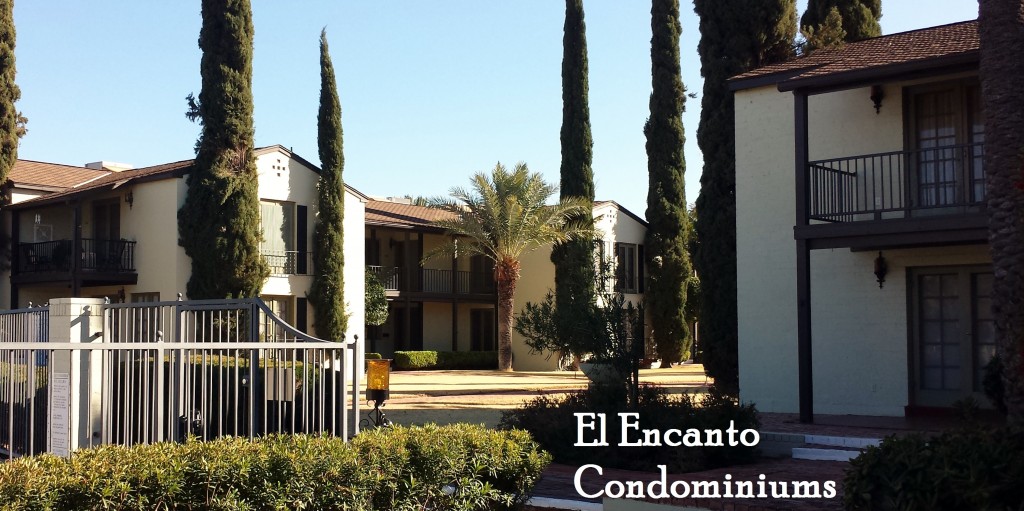
12. El Encanto Condominiums Historic District
El Encanto Condominiums – Built in 1942, this complex was originally designed to be Tucson’s first luxury apartment complex for winter visitors. El Encanto Condominiums is located conveniently on 6th Street near Country Club, within close proximity to the University of Arizona. Designed by Phoenix architect Orville Bell with local architect Arthur Brown supervising construction, this is one of few examples of Monterrey style architecture in Tucson.
The property was purchased in 1962 by a group of investors who re-developed the complex into condominiums. This condo conversion required adding on additional bedrooms and/or bathrooms to most of the units, as well as constructing several new buildings. The new structures followed the design closely and are hard to distinguish from the original buildings. The property features multiple courtyards, gardens, and a pool.
Search home for sale in El Encanto Condominiums

13. El Encanto Estates Historic District
El Encanto Estates is a beautiful historic neighborhood, established in 1928 and located in midtown Tucson, near Broadway and Country Club. When established, the location took advantage of the neighboring El Conquistador Hotel (which was torn down in the 1960s to make way for the El Con Mall). Most homes were built between 1929 and 1961. The neighborhood was entered into the National Register of Historic Places in 1988.
Some of the most unique things about the neighborhood is the formal symmetry of the spoke-shaped streets, the palm tree-lined roads, the large yards with impeccable landscaping, and the common area in the center of the neighborhood. The street names were chosen in a contest which requested Spanish names and their English translations, the winners were awarded $5 per winning entry.
More about El Encanto Estates
Search homes for sale in El Encanto Estates

14. El Montevideo Historic District
El Montevideo is a surprisingly semi-rural feeling neighborhood bordered by Broadway Boulevard, 5th Street, Alvernon Way, and Dodge. It is just north of Reid Park and east of El Con shopping center. This historic Tucson neighborhood was founded in 1930 with most homes built by 1961. The neighborhood features homes designed by many notable Tucson architects such as: Josias Joesler, Arthur Brown, William Wilde, Lew Place, and James Gresham. The styles range from Southwestern Revivals to Territorial, to Ranch, and Modern.
Search homes for sale in El Montevideo historic district
Interested in buying or selling a home in Tucson? Contact us to go over your needs. 520-975-8956 or Hello@RealTucson.com

15. El Presidio Historic District
The El Presidio neighborhood was the first Tucson neighborhood to be listed on the National Register of Historic Districts. El Presidio (the Spanish name for fort) is the oldest part of the city in the heart of downtown Tucson. Roughly bounded by 6th Street, Church, Alameda, and Granada. It ranks as one of the most walkable neighborhoods in Tucson, according to Walkscore.
Some homes were designed by prominent architects Holmes and Holmes and Henry Trost. The styles ranging from Sonoran Row houses to Bungalow, Territorial, and Mission Revival. Many early prominent Tucson families lived here including the Steinfelds, the Jacomes, Sam Hughes, and J. Knox Corbett.
Search homes for sale in El Presidio neighborhood

16. Feldman’s Historic District
Feldman’s is bounded by Speedway Boulevard to the south, Lee Street to the north, 7th Avenue to the west, and Park Avenue to the east, Feldman’s neighborhood was named after Alther Feldman who was an Eastern-European immigrant who moved to the US in 1958, eventually moving to Tucson in 1878. Feldman built his home near 1st Avenue and Speedway Boulevard (Speedway was once known as Feldman Street). The Feldman’s neighborhood was founded in 1901 with much of the building occurring in the 1920s.
The neighborhood is laid out in a rectangular grid pattern. Most homes are in the Bungalow, Spanish Colonial, or Ranch styles. By 1920, five tuberculosis sanatoriums were located in or near the Feldman’s district (Tuberculosis was once a leading reason to move to Tucson), one sanatorium was converted to an assisted living residence.
Search homes for sale in Feldman’s neighborhood
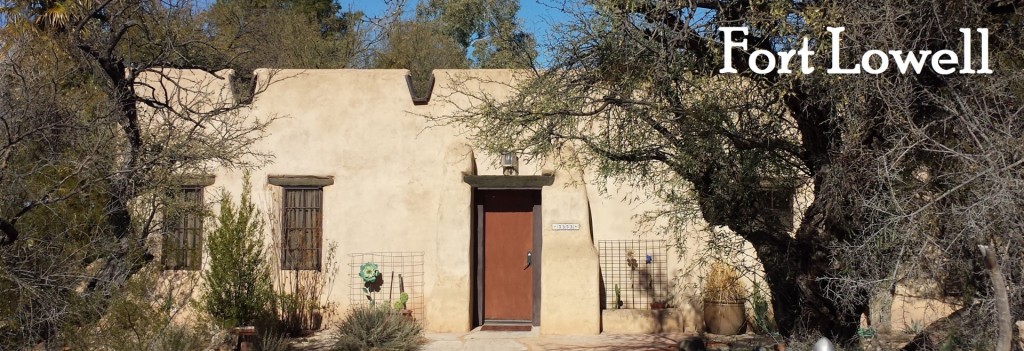
17. Fort Lowell Historic District
Fort Lowell was originally named Camp Lowell after Brigadier General Charles Russell Lowell, Jr. of Massachusetts who was killed at Cedar Creek, Virginia in 1862. In 1873, the Camp moved about 7 miles northeast from Tucson to the area that is now near Craycroft and Fort Lowell Road.
Fort Lowell was used primarily as a supply depot and served as protection from the Apaches, before being shut down in 1891 after its use was no longer needed. The adobe buildings were constructed around a rectangular parade ground. Some of the ruins can be seen today at Fort Lowell Park and across the street on the west side of Craycroft Road.
Prior to this period, the area had been inhabited by Hohokam people around 300 AD – 1400s. In the early 1900s, families from Sonora Mexico started moving to the area that they called “El Fuerte”. They initially moved into the abandoned fort buildings, but soon started building their own adobe buildings, including the San Pedro Chapel. The original chapel was destroyed in a tornado, but a new chapel was built on the site in 1932 and still exists as a neighborhood gathering site.
The historic houses within the district are Sonoran style, while many of the newer non-historic houses are contemporary, but built using similar materials. People are drawn to the area by the Rillito River (which is dry except after a substantial rains and/or mountain snowmelt) as well as the wildlife and mesquite bosques here.
Search homes for sale in Fort Lowell historic neighborhood
Interested in buying or selling a home in Tucson? Contact us to go over your needs. 520-975-8956 or Hello@RealTucson.com

18. Harold Bell Wright Estates District
Harold Bell Wright Estates located near Speedway Boulevard and Wilmot Road in Tucson, was named after a prolific early-20th century fiction author. Harold Bell Wright wrote 19 novels between 1903 – 1942. He is said to be the first American fiction author to sell over 1 million copies. 21 movies were based on his stories including The Shepherd of the Hills (made into a film starring John Wayne), and The Winning of Barbara Worth (one of Gary Cooper’s first films).
Wright suffered from tuberculosis and came to Tucson for his health, as so many people did back then. After living near the downtown area, he purchased a 160-acre parcel of land near Speedway & Wilmot in 1920. Wright liked the desert and wanted to get away from the city. After extensive planning, his home was finished in 1922. Wright moved to California in 1935 and sold his Tucson estate in 1936. Wright died in 1944 in California.
In 1950, the land was subdivided and turned into the Harold Bell Wright Estates. The land was divided into approximately 1/2 acre parcels and the streets were named after his books. The neighborhood is known for it’s large yards featuring desert landscaping. A community park is tucked away in a corner of the neighborhood with playground equipment and lots of grassy area to throw a Frisbee or kick a ball around.
More about Harold Bell Wright Estates
Search homes for sale in Harold Bell Wright Estates
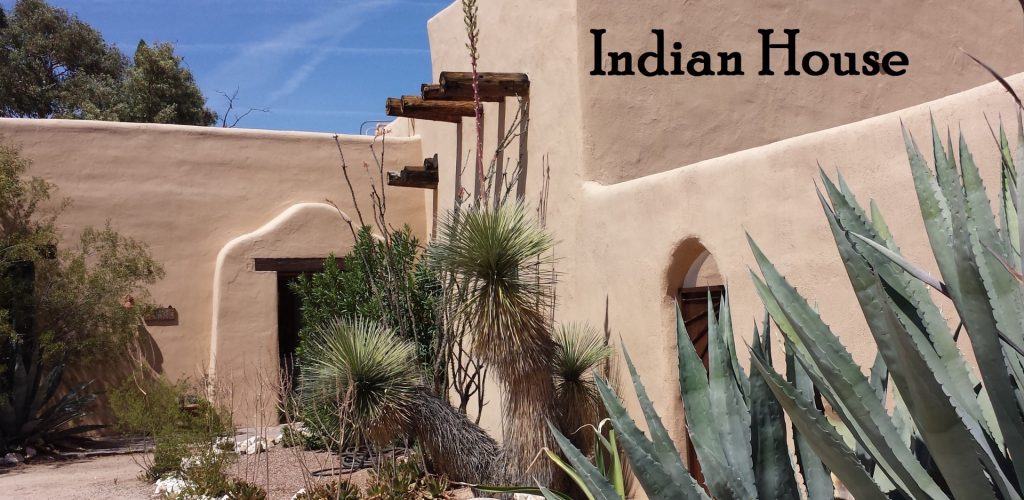
19. Indian House Historic District
Indian House is a small neighborhood consisting of only 11 properties on large rural lots ranging from 1 to 6 acres each. The neighborhood was once on the outskirts of Tucson but is now a rural oasis in the middle of the city. Located near 5th Street and Wilmot Road on an unpaved road, each home was built in the Pueblo Revival or Territorial Revival styles.
The land was purchased in 1926 by Charles Morgan and Nan Wood who intended to make Arizona their full-time home after a few winters spent here. After Charles’ sudden passing, Nan hired Santa Fe architect William P. Henderson to build her desert home in 1929. The land was sold to May S. Carr in 1949, who subdivided the property and put in place the deed restrictions which helped maintain the original character of the neighborhood. Some of the other homes were designed by Tucson architects Starkweather & Morse, and Gordon Luepke (who worked closely with Josias Joesler on several other projects).
Search homes for sale in Indian House neighborhood
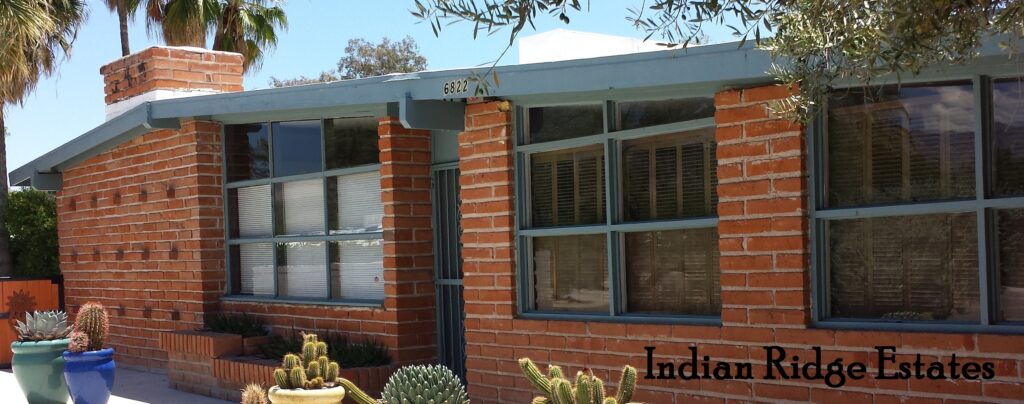
20. Indian Ridge Historic District
Indian Ridge Developed and built by the Lusk Corporation, this neighborhood includes Indian Crest Estates (1956) and Indian Ridge Terrace (1957). It is located on Tucson’s northeast side near Tanque Verde Road and Sabino Canyon Road in an area bordering ancient Indian ruins.
The neighborhood is known for the angular, single-story, low-slung ranch homes with asymmetrical pitched roofs, using uniquely southwestern materials such as burnt adobe and red brick. Large angled windows and sliding glass doors are ubiquitous in the neighborhood. Indian Ridge won the coveted Merit Award from the National Association of Home Builders in 1957 and was entered into the National Register of Historic Districts in 2010.
More about Indian Ridge neighborhood
Search home for sale in Indian Ridge Estates
Interested in buying or selling a home in Tucson? Contact us to go over your needs. 520-975-8956 or Hello@RealTucson.com

21. Iron Horse Historic District
Iron Horse neighborhood was named the most walkable neighborhood in Tucson by walkscore.com. The name of this historic Tucson neighborhood references the steam locomotive that became a familiar sight when the Southern Pacific Railroad (SPRR) arrived in Tucson in 1880. This neighborhood, just east of 4th Avenue and between 8th and 10th Streets, was established in the 1880s and continued being built out into the 1920s. Styles of homes include Sonoran, Territorial, Queen Anne, Bungalow, Spanish Revival, and Mission Revival.
It’s the only neighborhood in Tucson that was primarily developed for rental use and also consists of all these architectural styles. Many were duplexes or single family homes with an extra boarding room attached. Naturally, the neighborhood is distinctive because of the higher density and smaller lots. The railroad required employees to live within 1 mile of the tracks so they’d be able to hear the whistle codes, before the time of telephones. In 1910, 60% of the inhabitants of Iron Horse were railroad employees.
Search homes for sale in Iron Horse

22. Jefferson Park Historic District
Jefferson Park – Consists of parts of 5 subdivisions that were originally filed between 1905 and 1945. This popular neighborhood is only a half mile north of the University of Arizona. It is bounded by Grant to the north, Lester to the south, Campbell to the east, and Euclid to the west. The land was homesteaded in 1898 by Annie Stattelman Lester. The neighborhood started out as an informal rural community with no restrictions on home construction, lot size, or resident’s race (as was the norm at the time).
Bungalow, Spanish Colonial Revival, Pueblo Revival, Southwest, and Post-WWII Ranch style homes can all be seen here. The bulk of the homes in Jefferson Park were constructed after WWII and many were built of red brick. The neighborhood is unique because it is a rare surviving example of a rural subdivision that was slowly built up over a 60-year period, one house at a time. The neighborhood has an active, voluntary homeowner’s association.
Search homes for sale in Jefferson Park neighborhood
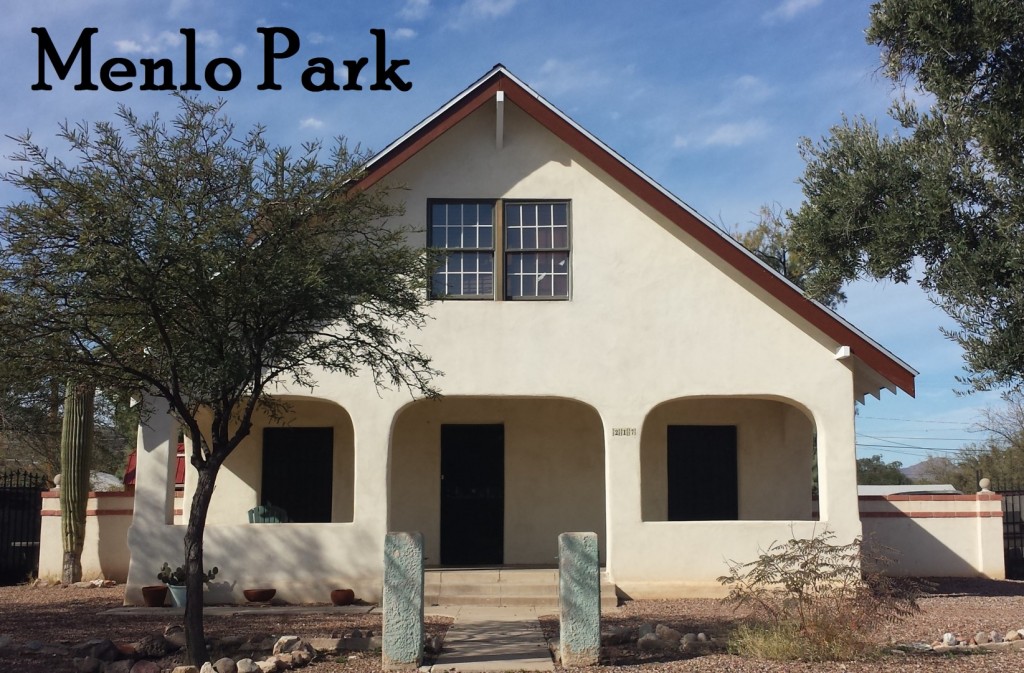
23. Menlo Park Historic District
Menlo Park – This west-side neighborhood is set in the shadow of “A” Mountain (Sentinel Peak), just west of I-10, downtown Tucson, and the Santa Cruz River. Platted in 1913, it was the first major subdivision west of downtown that was within city limits. The historic district has irregular borders, but is roughly between I-10 and Silverbell, both north and south of Congress Street.
Menlo Park was named by Henry Schwalen after the community in California, a town he never visited but read about that sounded ideal to him. The oldest home in Menlo Park was built in 1877, but homes continued to be built after WWII. Most residences are single family, but there are some duplexes and triplexes as well. The styles of the homes in Menlo Park are mostly Bungalow, Spanish Colonial Revival, Transitional Ranch, Ranch, Modern, and Vernacular. Waist-high fences that enclose the front yards are common in Menlo Park. The Mercado San Agustin and streetcar stop are popular draws to the area. Nearby, Tumamoc Hill and The Loop bike path at the Santa Cruz River are great places to get some exercise, drawing Tucsonans from all areas.
Search homes for sale in Menlo Park
Interested in buying or selling a home in Tucson? Contact us to go over your needs. 520-975-8956 or Hello@RealTucson.com

Orchard River Townhomes
Award winning Orchard River got it’s name because it’s nestled within an old pecan orchard and it’s adjacent to the Rillito River. Designed by local architect Robert Swaim in 1972, the community is comprised of 136 single-level and two-level homes. The neighborhood is also next to Fort Lowell Park and The Loop making it a great location.
Constructed of slump block masonry, the homes are sited to reduce solar heat gain by placing walls on the north and south. And the mature trees provide optimal shade. Each home has a small private yard. Resident parking consists of assigned covered carports and guest parking is available throughout the neighborhood.
More about Orchard River Townhomes and search homes for sale in the neighborhood
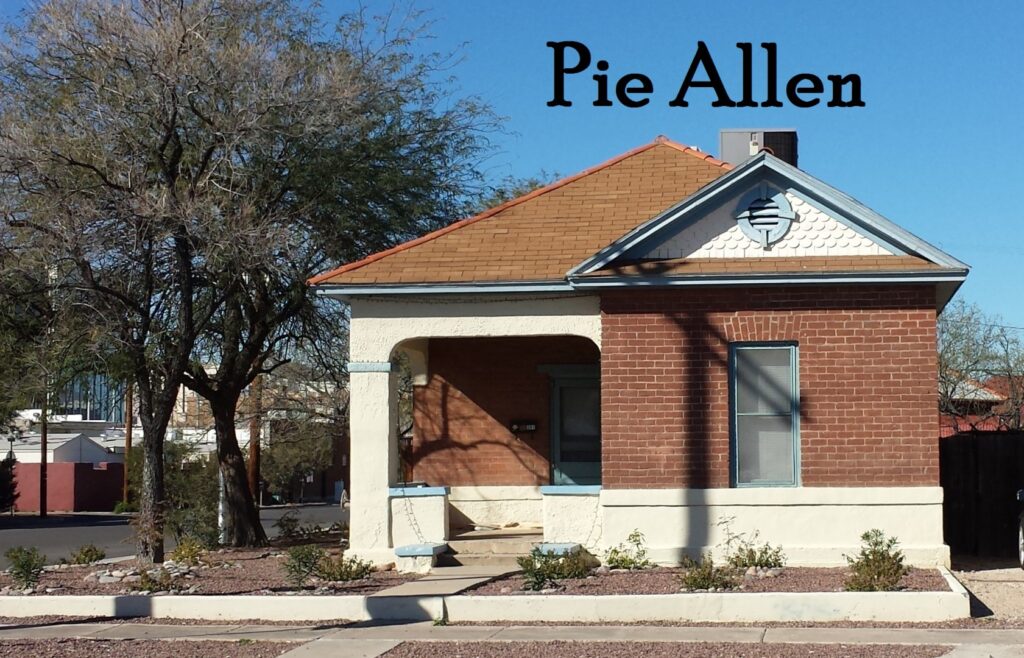
24. Pie Allen Historic District
Pie Allen – Named after John Brackett “Pie” Allen (1818-1899) who served as Tucson’s Mayor from 1875-1877. Allen also served on the Arizona Territorial Legislature and was appointed to be the Arizona Territorial Treasurer. Allen earned his nickname for the dried apple pies he sold to soldiers and other Territorial settlers for $1. Allen led the effort to move the Territorial Capitol from Prescott to Tucson in 1867.
The neighborhood that graces Allen’s name is between Euclid and Park Avenue and between 6th Street and 10th Street, sandwiched between Iron Horse Historic District to the west and Rincon Heights Historic District to the east. Pie Allen is similar to it’s bordering neighborhood, Iron Horse, as it was designed and built for tenants to live and housed many early railroad workers. Pie Allen is rated by Walkscore as the third most walkable neighborhood in Tucson.
Search homes for sale in Pie Allen neighborhood

25. Rincon Heights Historic District
Rincon Heights – Just south of the University of Arizona is Rincon Heights Historic District. It is bounded by 6th Street, Broadway, Fremont, and Campbell. The long build out from 1881-1970 means that many styles of homes are represented. Spanish Colonial Revival, Pueblo Revival, Bungalow, Craftsman, and Ranch can be seen here.
Historically, the lack of deed restrictions enabled Rincon Heights to be more affordable and attracted more middle-class residents to the modest sized houses. The neighborhood is now popular with University of Arizona students, due to its close proximity to the campus. Walkscore ranked Rincon Heights as the seventh most walkable neighborhood in Tucson.
The neighborhood gained historic district status in 2013.
Learn more about Rincon Heights neighborhood
Search homes for sale in Rincon Heights neighborhood

26. Sam Hughes Historic District
Sam Hughes is bounded by Speedway, Broadway, Campbell, and Country Club. Sam Hughes is named for the Tucson merchant who arrived here in the 1860s. Hughes helped incorporate the City of Tucson and he assisted in establishing public education here. Sam Hughes Elementary School was named for Hughes first, later the neighborhood surrounding the school adopted the name.
Most homes in the neighborhood were built in the 1920s through the 1950s. The architectural styles in the neighborhood are very eclectic, varying from California Bungalow to Pueblo Revival to Mission Revival to Craftsman styles. Many like Sam Hughes neighborhood because of it’s proximity to the University of Arizona directly to the west.
Himmel Park, a large city park featuring a small public library is also a popular feature of the neighborhood. Sam Hughes neighborhood, according to Walkscore, ranks as Tucson’s 9th most walkable neighborhood.
More about Sam Hughes neighborhood
Search homes for sale in Sam Hughes neighborhood
Interested in buying or selling a home in Tucson? Contact us to go over your needs. 520-975-8956 or Hello@RealTucson.com

27. San Clemente Historic District
The San Clemente neighborhood, which was named to evoke an image of the California town of the same name, received Historic District status in 2005. The boundaries are Broadway to the north, Timrod to the south, Alvernon to the west, and Columbus to the east.
The neighborhood was platted in sections between 1923-1946 with homes being built between 1930-1960. The more northern parts of the neighborhood are curvilinear, reminiscent of nearby Colonia Solana and El Encanto neighborhoods. The other section of the neighborhood is laid out in a grid to maximize the land usage. Most homes were designed in one of six ranch styles with a few revival homes in the mix.
This neighborhood also features 2 apartment complexes that were built in 1949. Randolph House is one of these apartment buildings that features beautiful landscaped grounds. San Clemente was home to notable residents like Evo And Ora DeConcini (parents of former Arizona senator Dennis DeConcini) and Tucson architect Bernard Friedman. This neighborhood continues to be popular due to it’s close proximity to El Con, Reid Park, Broadway Village, and the University of Arizona campus.
More about the San Clemente neighborhood
Search homes for sale in San Clemente neighborhood
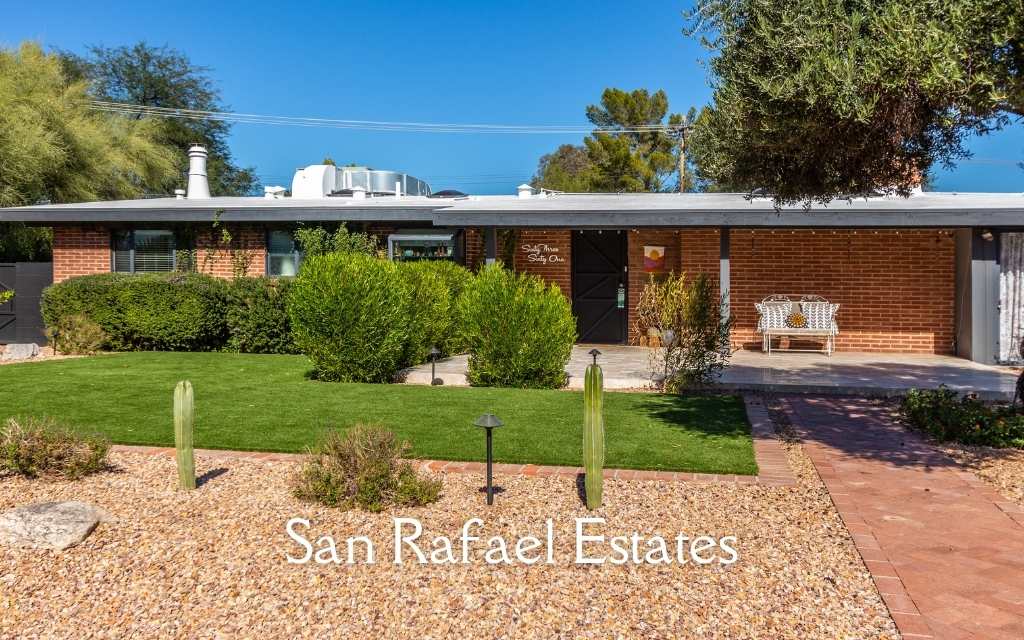
28. San Rafael Estates Historic District
San Rafael Estates – This neighborhood, developed by the Lusk Corporation, is located near Broadway and Wilmot on Tucson’s east side. This small neighborhood with 69 ranch style homes and a community pool consists of 3 floor plans: the ‘Lanai’, the ‘Monterrey’, and the ‘Homes for all America’. Each of these models had several elevations and materials/colors to choose from which made each home unique. Burnt Adobe was the main building material for the neighborhood. This project won the prestigious Merit Award from the National Association of Home Builders.
San Rafael Estates was entered into the National Register of Historic Neighborhoods in 2013.
More about San Rafael Estates
Search homes for sale in San Rafael Estates

29. Villa Catalina Historic District
Villa Catalina is one of the most recognizable communities in Tucson. It’s a wonderful example of mid-century modern architecture with its broad linear roof line and the unique square & circle shaped railings. The units were constructed between 1957 – 1960 at 6th Street and Country Club. The development was designed for patio apartment living, which was popular in the post-war era and was described as ‘Tucson’s first own your own apartment homes’. The developer, Lionel Mayell, built similar communities in other parts of Arizona, California, and Texas.
In 1992, Villa Catalina was converted to a 55 + community. The community was recently listed on the National Registrar of Historic Places in December 2009.
More about Villa Catalina
Search homes for sale in Villa Catalina

West University Historic District
West University was developed in the late 1800s to the early 1900s and became the first major subdivision north of the Southern Pacific Railroad. The location of West University neighborhood was convenient to both the railroad that arrived in 1880 and the University of Arizona, which opened in 1891. It developed into an area of town that attracted many community leaders in Tucson, including local politicians, store owners, educators, and architects. The Ronstadts and the Drachmans were notable residents.
During the territorial period (before statehood in 1912) there was quite a bit of building and land speculation which was stimulated by the development of the streetcar that opened in 1897, connecting the downtown area with the University of Arizona (sound familiar?).
The neighborhood is known for Bungalow style homes, about 50% are of this style. Many architects worked in West University, but Henry O. Jaastad (who also became Tucson’s mayor) was the most prolific archtect, designing about 50 of the area’s buildings.
West University is the second most walkable neighborhood in Tucson, according to Walkscore, having 2 major shopping/restaurant districts nearby: 4th Avenue and Main Gate Square. It also has a nice central community space in Catalina Park, a compact, grassy, tree-shaded block that has a wading pool and a children’s play area. The streetcar passes right through the neighborhood making it convenient for heading to the University of Arizona or downtown quickly.
More about West University Historic District
Search homes for sale in West University
Interested in buying or selling a home in Tucson? Contact us to go over your needs. 520-975-8956 or Hello@RealTucson.com

31. Winterhaven Historic Districts
Winterhaven is a popular central Tucson neighborhood that was established in 1949 and is known primarily for the annual Festival of Lights when 60,000 visitors walk, bike, or drive through the neighborhood after dark. The Festival of Lights event lasts 2 weeks each year in December.
The neighborhood is bounded between Prince (to the north), Fort Lowell (to the south), Tucson Boulevard (to the west), and Country Club (to the east). It is known for its ranch style homes, large pine trees, and rare Tucson lawns. Winterhaven was listed on the National Register of Historic Places on December 28, 2005.
More about Winterhaven historic neighborhood
Search homes for sale in Winterhaven
Have questions about buying or selling a historic Tucson home? Contact Nick: Nick@RealTucson.com or 520-975-8956
Resources for Tucson historic district homeowners
Many homeowners wonder what impact owning a home in a historic district makes. The City of Tucson has some great resources to help historic district property owners.
General information on National Register of Historic Places
These 5 factors are used to determine if a property qualifies for the National Register of Historic Places (NRHP):
- Properties must be 50 years or older.
- The property must have maintained most of its original integrity.
- Has the property been associated with a historic event or activity, or important historical person?
- Does the property have distinctive design or character?
- Does the property provide information about historic events?
What are the advantages for NRHP listed properties?
- There could be a significant savings in property taxes
- provides formal recognition of a property’s historical, architectural, or archaeological significance
- The property becomes part of the National Register Archives
- It encourages historic preservation
Are you interested in buying or selling a historic home in Tucson? Contact us today to go over your needs: Hello@RealTucson.com or 520-975-8956
Other related articles:
Eden Roc Gardens: Groovy Midcentury Modern Condos
Tucked Away in the Middle of Town Eden Roc Gardens is a midcentury modern condo…
Adobe Homes in Tucson: Timeless style
What is adobe? Adobe has been used throughout the world and is one of the…
Arts and Crafts home in Tucson, Take a look!
Take a look at this fantastic example of an Arts and Crafts home for sale…
Annie Rockfellow: A Master of Spanish Revival Architecture
Chances are, you haven’t heard of Annie Graham Rockfellow. Somehow, Arizona’s first female architect got…
Henry Jaastad – Architect and Tucson Mayor
Henry Jaastad was an important local figure in the early 20th century for 2 main…
Ice House Lofts – Tucson’s Coolest Neighborhood!
https://youtu.be/NMwsBGzH7bA Tour the Ice House Lofts community About the Ice House Lofts The Ice House…


